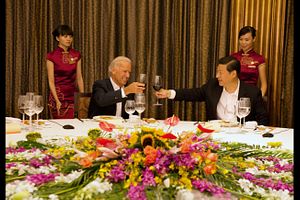The Biden administration’s strategy with China is widely anticipated to be a change in style but not substance from the Trump presidency. President-elect Joe Biden will arguably still perceive China as a major competitor, but his approach to deal with Beijing is bound to be less mean-spirited and arbitrary than Trump’s — more consistent and measured. Biden has promised to rebuild U.S. alliance with like-minded countries to pressure China into making changes. He will also likely broaden the litany of demands for changes, from market access to state involvements in the economy, from human rights issues to regional geopolitical conflicts. Biden will move beyond the simple transactional calculations of the Trump administration to command China’s good behavior.
Alas, if Biden’s ambition is still to wage a pressure campaign to gain concessions from China, he will face a number of formidable challenges.
First, to build an anti-China coalition is by no means an effortless task. The damages to U.S. leadership in the multilateral system under Trump are beyond easy and quick fixes. Trump backed out from the Paris Agreement, the World Health Organization, and the Trans-Pacific Partnership; belittled the NATO; paralyzed the World Trade Organization; and imposed trade barriers on Washington’s close allies. It is not clear that Biden will be able to gather sufficient bipartisan support to return to, or solidify, any of these multilateral arrangements. On some fundamental issues, such as regulations on data privacy and digital trade, the U.S. and the EU share deep disagreements. On trade and the economy, countries like Australia, Japan and South Korea find China an incredibly beneficial partner despite existing difficulties.
While Biden may be preoccupied by domestic issues and hamstrung in any attempt to rebuild coalitions, China has taken preemptive and forceful measures to elevate its position in the multilateral system. Signing the Regional Comprehensive Economic Partnership (RCEP) with 14 other Asia-Pacific countries solidified China’s status in regional trade and economic networks. With the EU, after seven years of drawn-out negotiations, the China-EU comprehensive investment agreement had a major breakthrough and is nearing a conclusion. It is speculated that China is willing to make unprecedented compromises to ink the deal so as to both box out the U.S. and to celebrate the centenary of the founding of the CCP. Xi has also expressed interest in joining the Comprehensive and Progressive Agreement for Trans-Pacific Partnership (CPTPP).
All these efforts have helped China establish itself as an increasingly important player in the multilateral system. Finally, even China seems more conciliatory under the multilateral system on matters that don’t touch on its hardline issues, as suggested by China’s cooperation on climate change initiatives, North Korean nuclear non-proliferation issues and reactions to the Ebola epidemic. It is unlikely that China will succumb to international pressure, even if it is concentrated, on some of its hardline issues such as the CCP rule and territorial unity.
Thankfully, there are areas where China and the United States share obvious, common interests, such as climate change and the battle against the coronavirus pandemic. And even on issues such as reducing trade imbalances, increasing market access and strengthening intellectual property protection, there is alignment with China’s long-term interests. Therefore, a possible tactic for Biden is not to pressure China into accepting rules that China deems unjust, unfair and coercive; but to exercise persuasion and offer guidance and help.
One good example is the matter of financial market opening. China is determined to reform and open its financial sector, partly because it is essential to shift from investment-driven growth to productivity-driven growth. China needs to introduce foreign competition and expertise to reform its financial sector to enhance capital allocation efficiency and improve the scope and depth of its financial market. As Chinese policymakers always favor gradual and incremental changes, the U.S. leadership must have patience and provide guidance and assurance for an orderly entrance into the market.
Similarly, on the issue of intellectual property protection, in order to advance its own domestically-grown technologies China needs to strengthen protection mechanisms. China’s IP office received 1.4 million patent applications in 2019, more than twice those filed in the U.S.; but that is still a 10.8 percent reduction due to changes in regulations aimed to optimize application structures and to improve the quality of patents. This suggests that China realizes there is much at stake in protecting intellectual property. But regulatory and institutional changes take time and immense effort. As it is well argued, China’s “fragmented authoritarianism” and its shortage of professionals to enforce the IP laws would inevitably slow down its progress. Seen in this light, the U.S. could be a welcomed partner in providing China with the technical expertise and frame of reference, rather than policing China into compliance.
The United States and China are too entangled to be decoupled and U.S.-China “coopetition” is possible. On many areas where the two countries share common interests, the U.S. should be pragmatic and diplomatic in showing how its objectives are consistent with China’s national interest, and in providing guidance and assistance rather than pressure and coercion. Meanwhile, the U.S. should recognize that deep, fundamental differences between the two countries will always exist. Complete rupture and a “cold war” with China is one possibility, while peaceful and mutually beneficial coexistence is another and better option.
Yan Liang is a professor of economics at Willamette University and a research scholar at the Global Institute for Sustainable Prosperity.

































